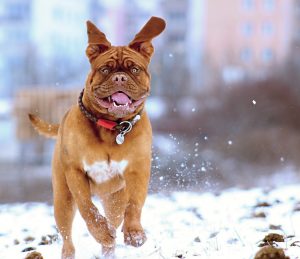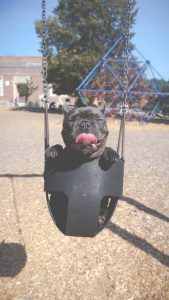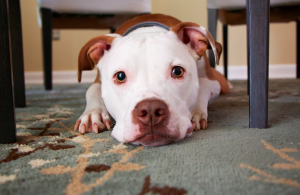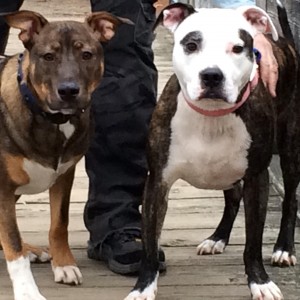 Are you a renter thinking about moving? Do you own a pit bull? As you can probably imagine, apartment hunting with a dog is a bit more difficult than apartment hunting without one. Many landlords don’t want to deal with the liabilities that come with renting to tenants with animals. This is especially true if that animal is a pit bull or bully breed dog. As pit bull owners are unfortunately well aware, bully breed-type dogs often face breed discrimination. As unfair as it may be (and as hard as we are trying to change the status quo!), it is likely something you, as a pit bull owner, will have to consider. Read on for our best tips on winning over those landlords and getting your fair choice of living quarters.
Are you a renter thinking about moving? Do you own a pit bull? As you can probably imagine, apartment hunting with a dog is a bit more difficult than apartment hunting without one. Many landlords don’t want to deal with the liabilities that come with renting to tenants with animals. This is especially true if that animal is a pit bull or bully breed dog. As pit bull owners are unfortunately well aware, bully breed-type dogs often face breed discrimination. As unfair as it may be (and as hard as we are trying to change the status quo!), it is likely something you, as a pit bull owner, will have to consider. Read on for our best tips on winning over those landlords and getting your fair choice of living quarters.
- Take your time. While many landlords are not dog-friendly, there are plenty that are. It just might take a bit longer to find them. If time permits, it is a good idea to plan ahead and be persistent in your search.
- Include a pet resume with your application. This can be especially helpful if you are attempting to sway a landlord who might not be normally willing to rent to tenants with dogs. It will show that you take pet ownership seriously and will directly address any concerns he/she may have.
- Also include letter(s) of recommendation. Along with your pet resume, consider attaching a couple of references from your current/past landlords, neighbors, groomers, and trainers who knew your dog, driving the point home that you are a responsible dog owner and your dog is properly trained and well-behaved.
- Meet and greet. If you are in a position to visit the landlord in person, it can be to your advantage to do so – with your dog, of course! It’s easier for landlords to decline dog owners over the phone or email, but harder if they meet you and your well-behaved dog in person. Be courteous and schedule an appointment first; dropping in unexpectedly will probably not be appreciated by most people! If you aren’t able to meet the landlord in person, be sure to include some high-quality photos of your dog with his/her pet resume.
- Offer an additional pet security deposit. Again, this will likely help ease the landlord’s mind over potential concerns and further catapult you into “ideal tenant” territory.
- Consider renter’s insurance. Be sure to buy a policy that covers your dog and make that clear in your application.
- Be honest. Don’t ever try to hide your dog or sign a lease that does not allow dogs. As cliche as it may sound, honesty is the best policy! You surely don’t want to risk being turned in by neighbors or found out by your landlord and potentially be evicted. It’s worth it to wait until you find a place that welcomes you and your pit bull.
- Hold up your end of the bargain. After all the campaigning you’ve done for you and your dog to be accepted as tenants, you must follow through and be an exceptionally responsible pet owner! Be respectful of your neighbors, pick up after your dog, keep him/her on a leash, etc. Doing so will set a positive example for those around you (serving as a breed ambassador) and you will hopefully be able to use your landlord as a reference for the next time you move.
We hope that you find these tips useful in your apartment search. If you think we missed anything important, please feel free to let us know in the comments!

 extraordinary value in the workforce. It is perhaps these qualities, coupled with their intelligence, loyalty, athletic ability, stamina, and drive, that make pit bulls the ideal pick for specialized jobs that have a significant impact on our society. A few jobs that pit bulls excel at include:
extraordinary value in the workforce. It is perhaps these qualities, coupled with their intelligence, loyalty, athletic ability, stamina, and drive, that make pit bulls the ideal pick for specialized jobs that have a significant impact on our society. A few jobs that pit bulls excel at include: There are a number of organizations across the nation that are dedicated to training pit bulls for the workforce.
There are a number of organizations across the nation that are dedicated to training pit bulls for the workforce.  comfortable.
comfortable. festivals, charity walks, meet-ups, and other celebrations during October. Even if you don’t own a pit bull, it’s a good opportunity to get out and meet some! Check your local shelter or rescue group for upcoming events.
festivals, charity walks, meet-ups, and other celebrations during October. Even if you don’t own a pit bull, it’s a good opportunity to get out and meet some! Check your local shelter or rescue group for upcoming events. Even further, the bylaw also creates two categories of dogs of all breeds: at-risk and dangerous. At-risk dogs are those that exhibit aggressive behaviour, such as biting. Dangerous dogs are those that have killed someone or are deemed dangerous by an expert. If a dog is “deemed dangerous,” he/she will also be subject to seizure and euthanasia.
Even further, the bylaw also creates two categories of dogs of all breeds: at-risk and dangerous. At-risk dogs are those that exhibit aggressive behaviour, such as biting. Dangerous dogs are those that have killed someone or are deemed dangerous by an expert. If a dog is “deemed dangerous,” he/she will also be subject to seizure and euthanasia.
 Under the current law, “if the owner of an animal that is being held in custody (by a local governmental unit or other person, such as a humane society, on behalf of a local governmental unit) is convicted of a crime related to animal fighting and the animal is one year old or older or shows indication of having participated in fighting, the animal must be euthanized.” This law did not allow for any kind of behavioral analysis or rehabilitation for the animal in question; it was an immediate death sentence. Under Bill 487, however, “if an animal has been taken into custody because it is believed that the animal has been used in any crime against animals or that it constitutes evidence of a crime against animals, it must be retained in custody.” The bill also allows the local governmental unit or other person with custody of the animal in question to demand payment from the animal’s owner for the custody, care, and treatment of the animal every 14 days.
Under the current law, “if the owner of an animal that is being held in custody (by a local governmental unit or other person, such as a humane society, on behalf of a local governmental unit) is convicted of a crime related to animal fighting and the animal is one year old or older or shows indication of having participated in fighting, the animal must be euthanized.” This law did not allow for any kind of behavioral analysis or rehabilitation for the animal in question; it was an immediate death sentence. Under Bill 487, however, “if an animal has been taken into custody because it is believed that the animal has been used in any crime against animals or that it constitutes evidence of a crime against animals, it must be retained in custody.” The bill also allows the local governmental unit or other person with custody of the animal in question to demand payment from the animal’s owner for the custody, care, and treatment of the animal every 14 days. It’s no secret that owning a dog comes with responsibility. But in many ways, owning a pit bull requires even more responsibility. Pit bull owners face some tough challenges, like breed stigmatization, discrimination, and bias. It’s not for everyone, but being a pit bull or bully breed owner can be one of the most rewarding experiences you could have.
It’s no secret that owning a dog comes with responsibility. But in many ways, owning a pit bull requires even more responsibility. Pit bull owners face some tough challenges, like breed stigmatization, discrimination, and bias. It’s not for everyone, but being a pit bull or bully breed owner can be one of the most rewarding experiences you could have.
